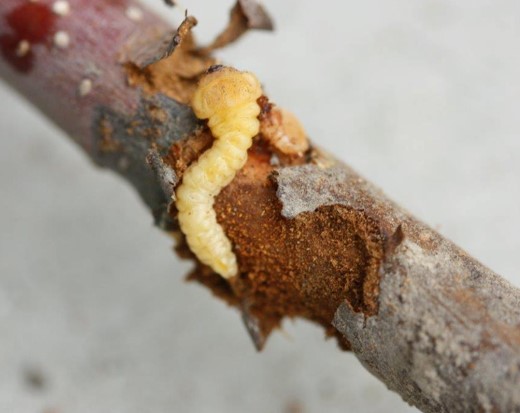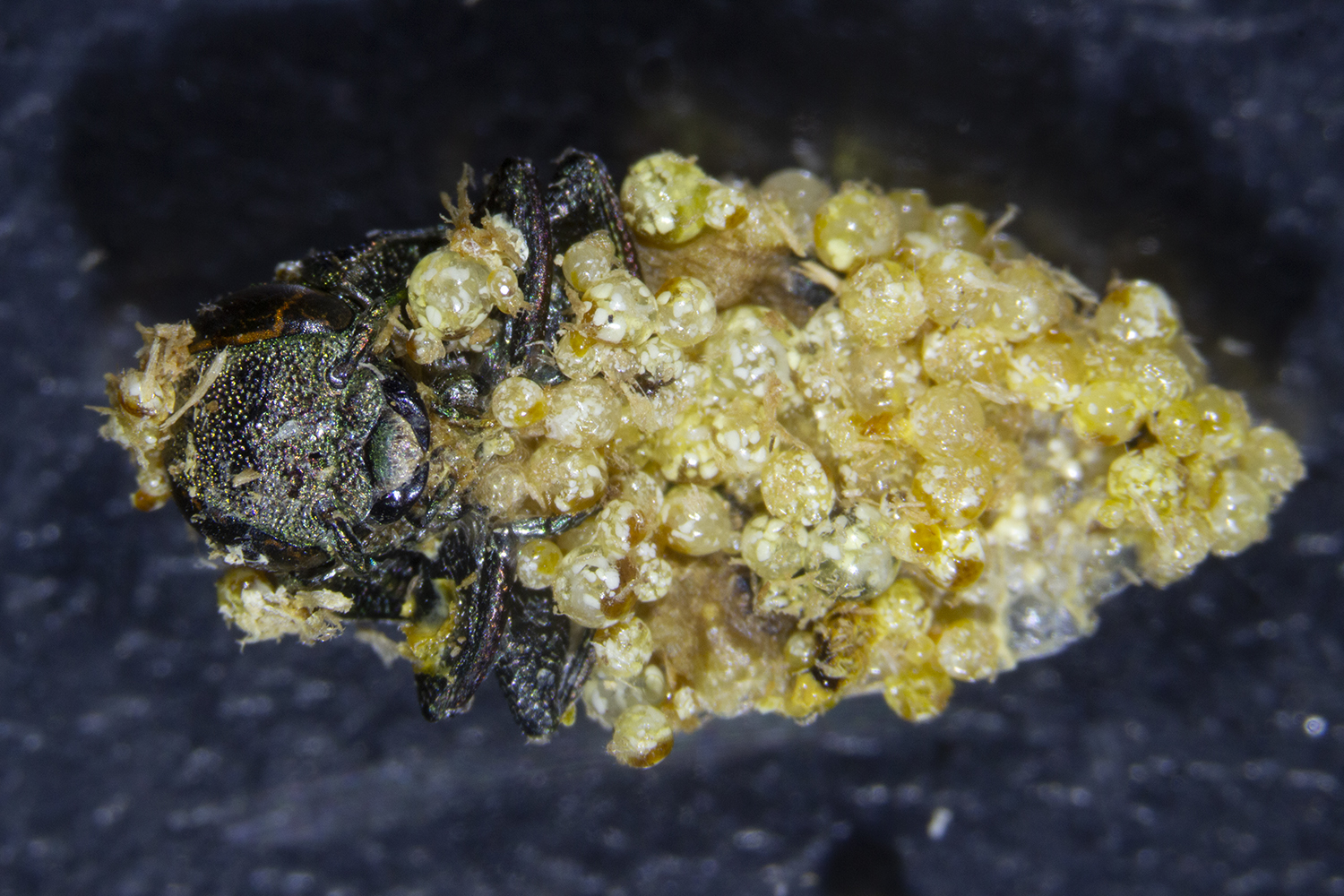What makes this a pest?

PFB larva. Photo credit: C. Hedstrom, ODA 
PFB adult. Photo credit: C. Hedstrom, ODA
Pacific flatheaded borer (Chrysobothris mali Horn) impacts a range of tree crops, including hazelnuts. Following egg hatch, young larvae burrow into the tree. Feeding activity in the cambium can lead to girdling, resulting in dieback or even death of the entire tree. Trees that do not show signs of stress following damage are more prone to breakage in future years with severe wind or heavy crop loads, because the feeding area compromises the structural integrity of the trunk. While PFB are particularly attracted to stressed young trees, they may also attack older weakened trees that are affected by blight, or that have recently experienced mechanical or herbicide damage. This pest is of increasing concern to growers, especially as hazelnut acreage in the Willamette Valley drastically rises. Therefore, there is potential for an increase in area wide pest pressure.
Signs of damage

Newly damaged tree. Photo: N. Wiman, OSU 
Bark peels from trunk when damage ages. Photo: N. Wiman, OSU
Control
Since PFB are attracted to stress signals emitted by trees, minimizing tree stress is the first form of defense against attack. The best preventative measures are:
- avoid sunburn by painting trunks with a mixture of white latex paint and water
- prevent water and nutrient stress by maintaining adequate soil moisture and applying nutrients as needed
- avoid any herbicide and/or mechanical injury to the trunk.
If area wide pest pressure increases sufficiently, it may become necessary to utilize additional controls such as insecticides. To date, there is limited information regarding the biology of PFB, particularly phenology and natural enemies. The main goals of our research are to acquire more information in both of these areas, as well as to evaluate the efficacy of several control measures, with particular emphasis on insecticides.
Current research trials
Basic biology of PFB- For the past three years, we have collected thousands of trees infested with PFB from grower orchards. After removing the canopies and roots, we cap the cut ends with paraffin wax to prevent desiccation, and place the infested wood in field cages. Each spring, several randomly selected trunks are dissected to evaluate borer development, and a weekly report is sent out to growers notifying them of insect development. Adult beetle emergence has been tracked each summer, and growers are notified of beetle activity via email to help them determine when to spray (if they wish to do so) for optimum efficacy.
Results
- PFB emerge over a long period of time- approximately 60 days.
- This poses a challenge to growers who wish to apply trunk sprays to protect their trees from PFB because many of the options currently registered for hazelnuts remain active for a short time period (about 14 days), and therefore must be applied multiple times in a season.

We are working to generate a phenology model based on the vast amount of data that has been collected. This will allow growers to accurately predict growth, timing of beetle flight, and egg laying. The development of traps baited with attractive lures (another area of research we are pursuing) will further help growers estimate beetle presence and pressure in their orchards.
Natural enemies of PFB – During studies of PFB development, we have found multiple ichneumonid parasitoid wasp species emerging in our field cages. There is also a parasitic mite that has been found attacking adult beetles.
In the summer of 2020 we reared another species (det. Joshua Vlach, ODA) of borer from infested wood that we had collected. The beetle was a longhorned beetle known as the nautical borer, and has never before been reported from hazelnut/filbert, but is known to utilize oaks as hosts.

Xylotrechus nauticus, the nautical borer. Photo: H. Andrews, OSU
Chemical efficacy tests – During the past three years, we have tested the efficacy of numerous products against PFB. We have found that planting young trees, and then stressing them by restricting water makes them very attractive to beetles. We then collect beetles that emerge in our field cages, and place them into the plot. This increases the pest pressure, and gives us something to test the products against. Through our research, we have found that imidacloprid drenches, sprays and soaks (unregistered) prior to planting provide excellent control of PFB. Clothianidin works well, which has led to Belay being registered for PFB in hazelnut. Diamide insecticides have also proven effective, and through our research we have demonstrated that one application of candidate materials provides season-long control, and that multiple applications is not necessary.




